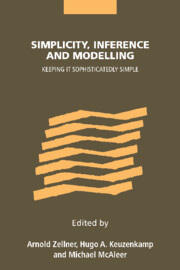Book contents
- Frontmatter
- Contents
- List of figures
- List of tables
- List of contributors
- 1 The enigma of simplicity
- PART I The importance of simplicity
- PART II Simplicity in theory and practice
- 8 Simplicity, information, Kolmogorov complexity and prediction
- 9 Simplicity and statistical inference
- 10 Rissanen's theorem and econometric time series
- 11 Parametric versus non-parametric inference: statistical models and simplicity
- 12 The role of simplicity in an econometric model selection process
- 13 Simplicity in a behavioural, non-parametric context
- 14 Keep it sophisticatedly simple
- 15 Communication, complexity and coordination in games
- 16 The simplicity of an earnings frontier
- 17 Simplicity: views of some Nobel laureates in economic science
- Index
11 - Parametric versus non-parametric inference: statistical models and simplicity
Published online by Cambridge University Press: 22 September 2009
- Frontmatter
- Contents
- List of figures
- List of tables
- List of contributors
- 1 The enigma of simplicity
- PART I The importance of simplicity
- PART II Simplicity in theory and practice
- 8 Simplicity, information, Kolmogorov complexity and prediction
- 9 Simplicity and statistical inference
- 10 Rissanen's theorem and econometric time series
- 11 Parametric versus non-parametric inference: statistical models and simplicity
- 12 The role of simplicity in an econometric model selection process
- 13 Simplicity in a behavioural, non-parametric context
- 14 Keep it sophisticatedly simple
- 15 Communication, complexity and coordination in games
- 16 The simplicity of an earnings frontier
- 17 Simplicity: views of some Nobel laureates in economic science
- Index
Summary
Introduction
The main objective of this chapter is to compare and contrast the two main approaches to modern (frequentist) statistical inference, known as parametric and non-parametric. The comparison focuses on their effectiveness in empirical modelling, i.e. how effective these two approaches are in enabling the modeller to learn about observable stochastic phenomena of interest. By interpreting simplicity of a statistical model in terms of parsimony and informational content, as they relate to the statistical information contained in the observed data, we proceed to compare parametric and non-parametric models. The main conclusion is that parametric models not only have a clear advantage over non-parametric models on simplicity grounds, they are also better suited for giving rise to reliable and precise empirical evidence.
In section 2 we explain the main difference between parametric and non-parametric models as they pertain to statistical inference. In section 3 we discuss the notion of simplicity as it relates to statistical modelling. In section 4 we compare parametric and non-parametric modelling in relation to statistical adequacy (the assumptions defining the models are not rejected by the observed data) and robustness. In section 5 we discuss the precision of inference as it relates to parametric and non-parametric modelling. In section 6 we consider an empirical example of descriptive correlation analysis in order to illustrate some of the issues raised in the previous sections.
- Type
- Chapter
- Information
- Simplicity, Inference and ModellingKeeping it Sophisticatedly Simple, pp. 181 - 206Publisher: Cambridge University PressPrint publication year: 2002
- 1
- Cited by



